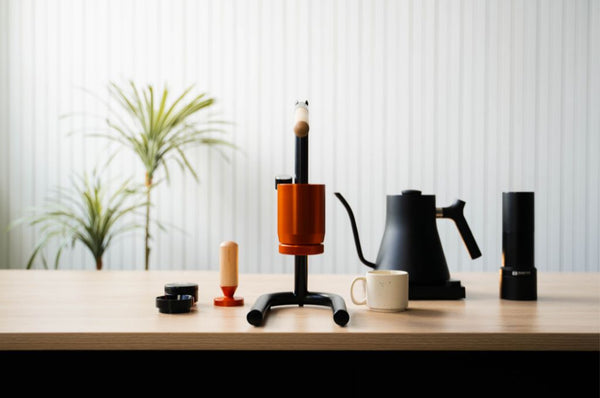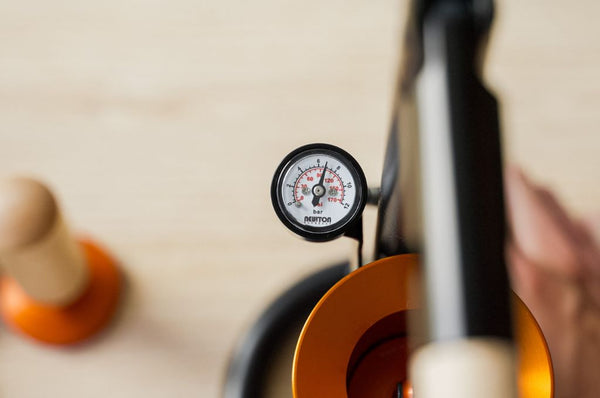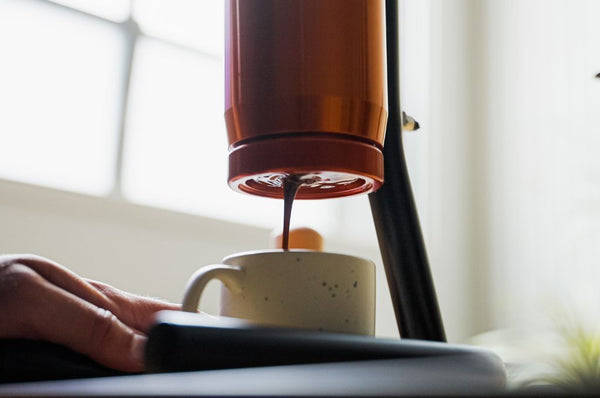Espresso Brew Pressure Explained
Brew Pressure - what it really means and how to use it to make fantastic coffee.
Have you been eyeing off that pressure gauge for your Newton BRUA? Trying to hit that magic 9 bar number you hear thrown around in coffee circles all the time?
That's right! It's time to talk about brew pressure. A subject, I feel sometimes, can be heavily featured and discussed, yet often misunderstood. Like always, we’re here to break it down for you so you’ll be brewing great coffee in no time. Most importantly, we will have you understanding your coffee extraction, so you, the home barista, can perfect that cup and repeat it consistently. Keep reading!

What is brew pressure?
When we say brew pressure, we’re referring to the pressure of the brew water being pushed through the coffee grinds during extraction.
Traditionally, it is said 9 bars of pressure is the optimum pressure to extract espresso. It needs to be understood, pressure is a derivative of other aspects of the brew process. This means pressure is directly affected by other variables, in this case, water flow and the resistance created from the coffee bed.
To put it in a simple formula;
Pressure = Flow / Resistance or Pressure is equal to flow divided by the resistance.
Now that we know pressure is directly affected by both these key elements, it can be understood that it is only PART of the extraction equation. While we should monitor pressure by feel or a gauge, achieving 9 bar (like often said) is not the make or break of a great espresso. Instead it is another variable we can control and manipulate to tailor our espresso to our personal preference.

How does pressure affect the extraction?
It’s true, espresso needs pressure to extract. It really can't be espresso unless it is brewed with both heat and pressure. Where the confusion comes in, is how much pressure is required to generate both crema and a great tasting espresso.
Surprising to many people, 4-6 bars of pressure is sufficient to produce espresso, not the 9 bars you often see talked about.
Brewing at the pressure of 9 bars can produce tasty shots of coffee, no doubt! Yet higher pressures can also exploit weak points in the coffee bed, creating channels and harsh flavors in the cup. Reducing pressure down to around 6bar can help improve consistency between shots and reduce the chance of channelling, creating more even, efficient and tasty espressos over a range of shots.
We carried out some extraction tests at both 6 and 9 bars of pressure to give you an idea of the differences we noted. Using a refractometer to measure total dissolved solids (TDS) and in turn extraction yield (EY), the finding of 20 shots each, pulled with the same coffee, equipment, recipe and preparation was surprisingly very similar.
- Both the 9 bar shots and the 6 bar shots fell in an acceptable extraction range of 18-22%.
- The 6 bar shots had a lower standard deviation than the 9 bar.
- The mean (average) of 9 bar extraction yield, was lower than that of the 6 bar extraction.
This gives us an indication that both 9 bar and 6 bar extractions give similar results. The 6 bar extractions were slightly more efficient and consistent. This lends to the theory that reducing the pressure on the puck helps to even water saturation and reduce channelling within the coffee bed.
We can also see that while figures show how much we are extracting from the coffee bean, it is not a good indicator of flavour.
Both 9 and 6 bar brew pressure produce tasty shots, both for milk and black coffee. The trend overall was the 6 bar shots were more rounded, higher clarity and with more perceived sweetness. The 9 bar shots tended to have a more noticed astringency and acidity across the range, but also with a more syrupy body.

How to change your pressure.
As we covered above, pressure is directly related to water flow and resistance. We can change our pressure level on a manual brewer by increasing how hard we press our lever, (increasing the flow). We can also increase pressure by grinding finer or increasing our dose (increasing resistance).
There are more advanced versions of pressure manipulation, grinding much finer than normal, applying pressure and holding it on for a 20-30 second pre brew. This will help reduce resistance in the puck by lowering the pressure, coupled with a gentle consistent water flow for the rest of the extraction which can produce some incredible shots. This technique takes practice and patience and ends with a shot time closer to 90 seconds (30 seconds of this would be a pre-infusion).
What pressure should you extract at?
With the above knowledge, you can now decide what works best for you. A large range of pressures can work for extraction, so if you are chasing a higher body and using an easy to extract coffee, reaching 8-9 bars can help produce that thick syrupy taste, on the flip side, it can expose imperfections in your puck prep.
If you chase higher clarity, a more balanced, rounded and consistent espresso, I recommend reducing your pressure to around the 6 bar realm. The reduced pressure helps with even water flow and produces a beautiful shot, especially if you drink your coffee black.
As your confidence grows with manipulating pressure, you may find it best to hit 9 bars and decline pressure throughout the brew. This helps achieve the best of both worlds.

What if I don't have a pressure gauge?
All is not lost! You can get a pretty good idea from feel! In fact, I find feel and instinct, the best method for manual brewing.
We will give you the hot tip, if you are not exerting some heavy pressure on that lever, you probably aren't hitting 9 bar and that's ok! If you ask us here at team Newton, we tend to land in the 6 - 6.5 bar camp for most of our shots - applying moderate pressure on the lever.
Actually, chasing a fixed number for pressure can be counter intuitive. This can be a downside of pump driven machines. Because the pump tries to stay at the set 9 bars of pressure as the shot reaches the last part of extraction and the puck degrades causing a resistance drop.
The pump needs to increase flow to stay at or close to the set pressure and this can increase channels and over extract parts of the coffee bed. The best technique in this situation is to decline water flow and reduce the pressure, to allow a more even extraction. This is best done by feel.
Use your feel, use your instinct, use your gauge. Practice and take note of how much pressure you apply. Before you know it, it will be second nature!
Final thoughts
We get asked about pressure a lot! Sometimes I think too much.
Pressure is only part of the equation, like grind, dose, temp and yield. There is no magic number for pressure, like there is no magic number for grind size or extraction time. They all work together in an intricate balance.
To produce great espresso consistently takes some understanding of all of these aspects and lots of practice. If you have followed along with our topics so far, you will start to have a really good understanding about getting the best results. The more you taste with intent and take note of how different elements of the extraction affect flavours, the better your coffees will be.
Enjoy the journey that coffee brings, none of us have made it all the way to the end yet.
Until next time.





